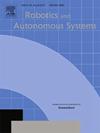Kinematics analysis and performance optimization of a novel asymmetric parallel biped robot
IF 4.3
2区 计算机科学
Q1 AUTOMATION & CONTROL SYSTEMS
引用次数: 0
Abstract
The asymmetric parallel mechanism offers advantages such as strong bearing capacity, flexible kinematics, and a large workspace, which conventional mechanisms cannot simultaneously achieve. However, few studies have applied it to the structural design of biped robots, resulting in a lack of a comprehensive theoretical system for analyzing the kinematic characteristics of such biped robots. This paper addresses this gap by analyzing a novel type of asymmetric parallel biped robot with common hinges and optimizing its dimensions. A method for degrees of freedom analysis based on the screw system is introduced. By combining the screw method with Lie algebra, a decoupled kinematic model is established, and the Jacobian matrix is derived. The workspace is determined using the Monte Carlo method. The distribution of singularity, the dexterity over time, and the stiffness mapping in two-dimensional space are obtained and analyzed based on the Jacobian matrix. Particle swarm optimization is employed to optimize the linkage length. Finally, the improvement of the optimized performance and the correctness of the kinematic derivation are validated by the gait experiment. This study offers valuable insights into exploring the kinematic characteristics of asymmetrical parallel mechanisms with common hinges, not only within the realm of biped robots but also in the broader field of multi-legged robots.
一种新型非对称并联双足机器人运动学分析与性能优化
非对称并联机构具有承载能力强、运动灵活、工作空间大等优点,是传统机构无法同时实现的。然而,将其应用于双足机器人结构设计的研究很少,导致缺乏一个全面的理论体系来分析这类双足机器人的运动特性。本文通过分析一种新型非对称并联双足机器人,并对其尺寸进行优化,解决了这一问题。介绍了一种基于螺杆系统的自由度分析方法。将螺旋法与李代数相结合,建立解耦的运动学模型,推导出雅可比矩阵。使用蒙特卡罗方法确定工作空间。基于雅可比矩阵,得到并分析了奇异性分布、灵巧度随时间的变化和刚度在二维空间中的映射。采用粒子群算法对连杆长度进行优化。最后,通过步态实验验证了优化性能的提高和运动学推导的正确性。该研究不仅在双足机器人领域,而且在更广泛的多足机器人领域,为探索具有普通铰链的非对称并联机构的运动学特性提供了有价值的见解。
本文章由计算机程序翻译,如有差异,请以英文原文为准。
求助全文
约1分钟内获得全文
求助全文
来源期刊

Robotics and Autonomous Systems
工程技术-机器人学
CiteScore
9.00
自引率
7.00%
发文量
164
审稿时长
4.5 months
期刊介绍:
Robotics and Autonomous Systems will carry articles describing fundamental developments in the field of robotics, with special emphasis on autonomous systems. An important goal of this journal is to extend the state of the art in both symbolic and sensory based robot control and learning in the context of autonomous systems.
Robotics and Autonomous Systems will carry articles on the theoretical, computational and experimental aspects of autonomous systems, or modules of such systems.
 求助内容:
求助内容: 应助结果提醒方式:
应助结果提醒方式:


